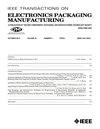Modeling of the Fluid Volume Transferred in Contact Dispensing Processes
IEEE Transactions on Electronics Packaging Manufacturing
Pub Date : 2009-05-29
DOI:10.1109/TEPM.2009.2020515
引用次数: 16
Abstract
In the contact dispensing process, the contact of the fluid with the target board is essentially needed in order to transfer a certain volume of fluid to the board. Due to the action of surface tension, part of the fluid extruded from the needle hangs on the needle after the process, and this causes the difference between the fluid volume extruded and the one transferred to the board. This difference is usually ignored in the literature, yet is critical to the precise process control. In this paper, a model to represent the difference is developed based on the Young-Laplace capillarity equation as well as the boundary conditions established for this particular problem. Experiments and simulations were carried out to verify the model effectiveness as well as to investigate the influence of the fluid volume extruded from the needle, the needle size, and the initial height of the needle on the fluid volume transferred in the contact dispensing process.接触点胶过程中流体体积传递的建模
在接触点胶过程中,基本上需要流体与靶板接触,以便将一定体积的流体传递到板上。由于表面张力的作用,从针筒挤出的部分流体在加工后挂在针筒上,这就造成了挤出的流体体积与输送到板子上的流体体积之间的差异。这种差异通常在文献中被忽略,但对精确的过程控制至关重要。本文根据Young-Laplace毛细方程和为这一特殊问题建立的边界条件,建立了一个表示这种差异的模型。通过实验和仿真验证了该模型的有效性,并研究了针头挤出的流体体积、针头尺寸和针头初始高度对接触点胶过程中流体传输体积的影响。
本文章由计算机程序翻译,如有差异,请以英文原文为准。
求助全文
约1分钟内获得全文
求助全文

 求助内容:
求助内容: 应助结果提醒方式:
应助结果提醒方式:


